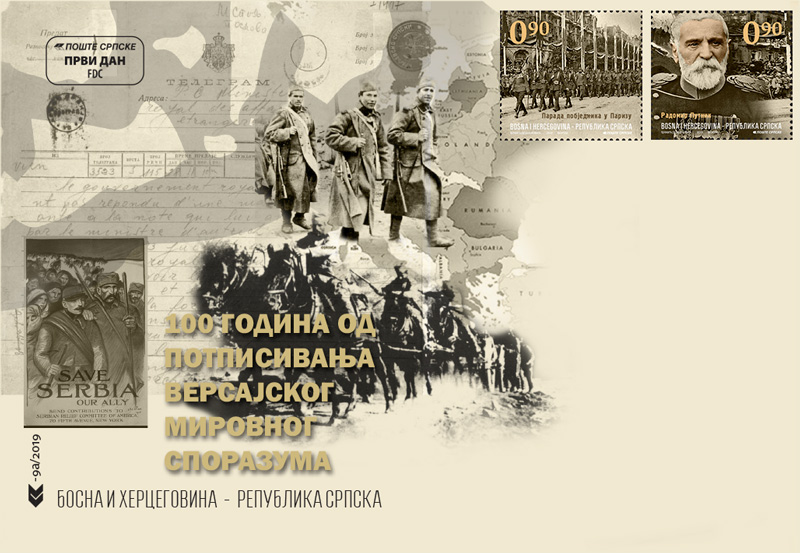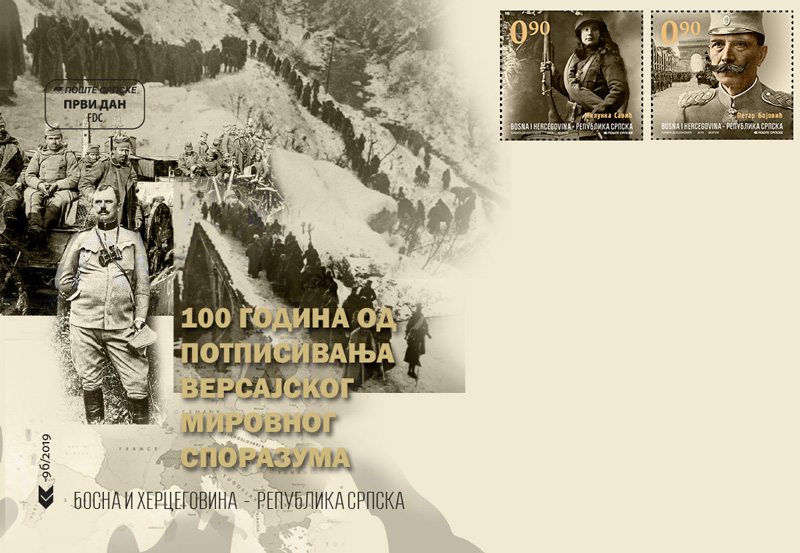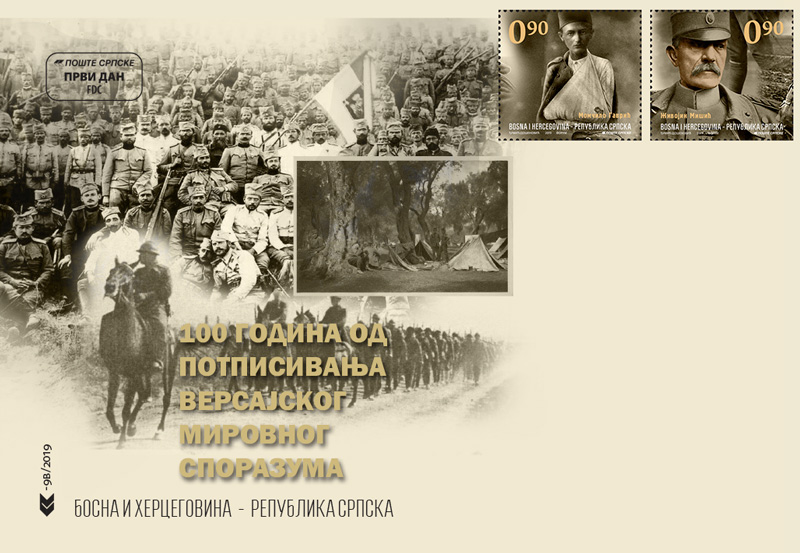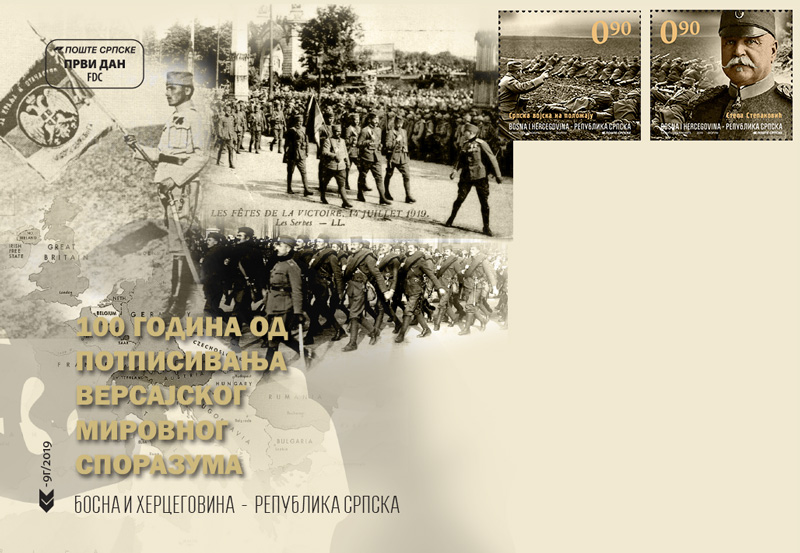100 Years from the signing Treaty of Versailles
Title::100 Years from the signing Treaty of Versailles
Date of Issue:28.06.2019.
Author:Djumic/Dosenovic
Type edition:commemorative
Printing techniques:multicolour offset
Sheet:8+1
Paper:muflep 100g
Printing House:Forum, Novi Sad
 Motive: Radomir Putnik
Motive: Radomir Putnik
Каталошки број:807
Perforation:13 3/4
Face value:0.90 BAM
Quantity:15 000

Motive:Victory parade in Paris
Каталошки број:808
Perforation:13 3/4
Face value:0.90 BAM
Quantity:15 000

Motive:Petar Bojovic
Каталошки број:809
Perforation:13 3/4
Face value:0.90 BAM
Quantity:15 000
 Motive:Milunka Savic
Motive:Milunka Savic
Каталошки број:810
Perforation:13 3/4
Face value:0.90 BAM
Quantity:15 000
 Motive:Zivojin Misic
Motive:Zivojin Misic
Каталошки број:811
Perforation:13 3/4
Face value:0.90 BAM
Quantity:15 000
 Motive:Momcilo Gavric
Motive:Momcilo Gavric
Каталошки број:812
Perforation:13 3/4
Face value:0.90 BAM
Quantity:15 000
 Motive:Српска војска на положају
Motive:Српска војска на положају
Каталошки број:813
Perforation:13 3/4
Face value:0.90 BAM
Quantity:15 000
 Motive:Stepa Stepanovic
Motive:Stepa Stepanovic
Каталошки број:814
Perforation:13 3/4
Face value:0.90 BAM
Quantity:15 000

The First World War officially began on July 28th 1914, a month after the Sarajevo assassination, in which Gavrilo Princip killed the Austro-Hungarian heir to the throne Franjo Ferdinand. The Serbian people, though exhausted by warfare into two Balkan wars, are boldly defended in this war. The price of the victory over the enemy was terrible. Compared to the number of inhabitants, Serbia has submitted the largest victims among all participating countries in the First World War ...
1914 - Killing of Serbs, destruction of their property, and general terror in Bosnia and Herzegovina came at the same time as the July crisis in which the powers of entente and the Kingdom of Serbia sought to avoid the war. On July 23rd, Austro-Hungarian sent an ultimatum to Serbia, which was so slated that Serbian leadership had to reject it. Five days later, the "Double Monarchy" declared the war to Serbia by telegram, and the Serbian government declared the general mobilization of the population.
The Austro-Hungarian army sent an army under Oscar Pocorek's command, and an attack on Serbia on August 12th began. The commander of the Second Army, General Stepa Stepanovic, formed on August 15, "Cer Impact Group", who attacked Austro-Hungarian positions the following night, commencing the famous Cer Battle. After defeating enemy positions on August 19th and taking key tops of Cer, the Serbian Army won the first victory of the Great War allies, Stepa Stepanovic was promoted to the rank of Duke, and Stanislav Binicki in honor of this victory and the commander of "Iron Regiment" Milivoja Stojanovic, composes "March at Drina". In a great contraattack, and in tune with the Montenegrin army, the Serbian army occupies most of Eastern Bosnia and is near Sarajevo.
After Cer battle, there was a battle on the Drina and a new Serbian victory. Austro-Hungarians are attacking Serbia again at the end of the year. After the initial withdrawal, Mayor of the Supreme Command, Duke Radomir Putnik, moves to offensive action on December 3rd. Pocorek did not expect this offensive of the Serbian Army, so his troops soon found themselves in complete chaos. The withdrawal of the enemy over the Drina and Sava lasted until December 15th, when the Kolubara battle was over. For successful command of the First Army in this battle, Zivojin Misic won the rank of Duke. Sholder to sholder, with him was Serbian heroin Milunka Savic, who will become the most decorated woman in the First World War.
Author: Nebojsa Djumic and МА Bozidar Dosenovic
Cooperation: Goran Barac, publicist from Banjaluka and Aleksandar Kostovic, historian
Publisher: Poste Srpske ad Banjaluka

The First World War officially began on July 28th 1914, a month after the Sarajevo assassination, in which Gavrilo Princip killed the Austro-Hungarian heir to the throne Franjo Ferdinand. The Serbian people, though exhausted by warfare into two Balkan wars, are boldly defended in this war. The price of the victory over the enemy was terrible. Compared to the number of inhabitants, Serbia has submitted the largest victims among all participating countries in the First World War ...
1915 - After the victory in the Kolubarska battle, a nine-month deadlock occurred in the territory of Serbia, during which a war on diseases and epidemics was struck, affecting both the army and the people. During that time, commander of the joint Austro-Hungarian and German forces, General Field Marshal August Fon Makenzen, plagued the plan for a new attack on Serbia. In the autumn of 1915, he had a powerful armada of 800,000 troops to his conquering attack on Serbia. 300,000 of ill and exhausted Serbian soldiers waited for them, who the Allies had left behind.
Artillery cannonade began on October 6th. The primary target of the attack was Belgrade, where beside the heroic defense, the Belgrade front broke out two days later, and from that moment on, systematic suppression of Serbian forces began towards the south of the country. Because of the enormous overwhelming of enemies on all fronts, the Serbian Government and the Supreme Command have made the decision that the army, across Montenegro and Albania, will retreat to the Adriatic coast. Members of the Government on this occasion started off on November 24th from Prizren, and the outcast Serbian soldiers, officers and refugees went out for them. On the frozen paths, trails, and wilderness of the Albanian glens, they moved very slowly. Serbian warriors and children were attacked by annihilation, hunger, coldness and constant attacks by Arnauts.
By the end of 1915, around 140,000 soldiers and officers arrived on the Adriatic coast. Among them was the youngest corporal in the world, nine-year-old Momcilo Gavric. It is assumed that about 72,000 people lost their lives in the snow and ice of the Albanian and Montenegrin mountains.
Author: Nebojsa Djumic and МА Bozidar Dosenovic
Cooperation: Goran Barac, publicist from Banjaluka and Aleksandar Kostovic, historian
Publisher: Poste Srpske ad Banjaluka

The First World War officially began on July 28th 1914, a month after the Sarajevo assassination, in which Gavrilo Princip killed the Austro-Hungarian heir to the throne Franjo Ferdinand. The Serbian people, though exhausted by warfare into two Balkan wars, are boldly defended in this war. The price of the victory over the enemy was terrible. Compared to the number of inhabitants, Serbia has submitted the largest victims among all participating countries in the First World War ...
1916/1917 - After the Albanian Golgotha, the Serbian army and civilians on the Adriatic coast have come up with new suffering. The Allies did not provide them with adequate acceptance, and only after the threat of the Russian Emperor, to break the alliance with England and France, if they did not help the Serb army and civilians, the rescue operation of the Serbs from Albania started. By February 15th, on the Greek island of Corfu was transported close to 135 thousand, and in Bizert, fewer than 10 thousand people.
Among the extravagant, hungry and ill Serbs, their deaths were taking their tribute. The island of Vido was called "the island of death," because in the sea around it - the "blue tomb" - about 5,400 dead Serbian soldiers dropped. Still, at the beginning of the spring of 1916, with better weather, constant medical help and regular nutrition, the old warriors began to recover, both physically and mentally. Three Serbian armies were formed, whose members began to be deployed on the Thessaloniki Front. The main source for filling the crowd with fresh people were Serbian volunteers from overseas countries as well as volunteers - prisoners of war in Russia, members of the Austro-Hungarian army, among them most Serbs from the territory of Bosnia and Herzegovina.
In the battles that were conducted during the autumn of 1916, the regenerated Serbian Army occupied strategically important Kajmakcalan, and then released Bitola by revoking and acquitting the first piece of motherland.
At that time, in the "dual monarchy" area, Serbs were judged in assembled processes. On the bloody pages of history, the famous "Banja Luka high treason process" was noted against 156 prominent Serbs, which ended on April 22, 1916, and in which - as Monarchy's enemies - sixteen of them were sentenced to death.
Author: Nebojsa Djumic and МА Bozidar Dosenovic
Cooperation: Goran Barac, publicist from Banjaluka and Aleksandar Kostovic, historian
Publisher: Poste Srpske ad Banjaluka

The First World War officially began on July 28th 1914, a month after the Sarajevo assassination, in which Gavrilo Princip killed the Austro-Hungarian heir to the throne Franjo Ferdinand. The Serbian people, though exhausted by warfare into two Balkan wars, are boldly defended in this war. The price of the victory over the enemy was terrible. Compared to the number of inhabitants, Serbia has submitted the largest victims among all participating countries in the First World War ...
1918 - Allies concentrated around 625 thousand of soldiers, including 140,000 Serbs, concentrated on the Thessaloniki Front by the beginning of September. At dawn on September 14th, 1918, artillery preparation began, and the day later, the infantry attack of the Serbian Second Army began on Bulgarian positions. Worn by the enormous desire to release the homeland, the Serbian warriors fully mastered the Vardar Valley by the end of September.
Powerless in front of a powerful blow by the Serbian Army, Bulgarians signed the capitulation on September 29-30, 1918. Full of merit and confidence, Serbian warriors continued to go to the enemy and liberate the villages and towns, and in Belgrade, they got victory on November 1st. Two days later, the Austro-Hungarians capitulated, and on November 11th, powers of Antanta signed the truce with Germany. For merit on the battlefield during the penetration of the Thessaloniki Front, Commander of the First Serbian Army, General Petar Bojovic, was given the rank of Duke.
Following the liberation of Serbia, the Serbian army continued with an offensive action to expel the enemy from all the South Slavic areas where the National Movements have already pleaded for the unification with Serbia. At the invitation of the new government in Sarajevo, the first units of the Second Serbian Army entered the territory of Bosnia and Herzegovina through Visegrad on November 4th, after which the Duke Stepa commanded an accelerated march to Sarajevo, to which the Serbian army entered on November 6th, while Banja Luka welcomed the liberators until 21st of November.
On December 1st, 1918, the first Yugoslav state - the Kingdom of Serbs, Croats and Slovenes - was created in Belgrade, and the First World War was officially completed by the signing of the the Treaty of Versailles on June 28th, 1919.
Author: Nebojsa Djumic and МА Bozidar Dosenovic
Cooperation: Goran Barac, publicist from Banjaluka and Aleksandar Kostovic, historian
Publisher: Poste Srpske ad Banjaluka
 1371
1371  kontakt@postesrpske.com
kontakt@postesrpske.com


